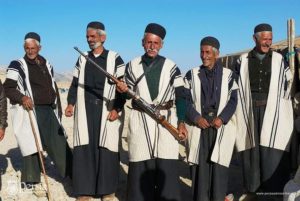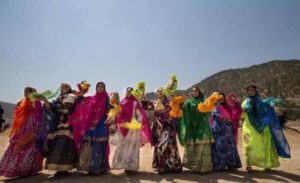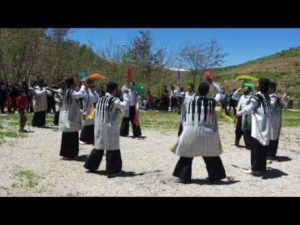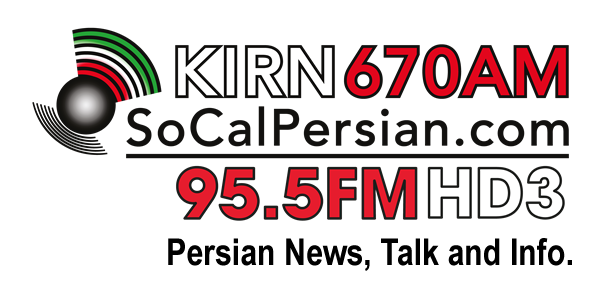
The Bakhtiari is Lur tribe.They speak the Bakhtiari dialect, a southwestern Iranian dialect, belonging to the Luri language. Bakhtiaris primarily inhabit Chaharmahal and Bakhtiari and eastern Khuzestan, Lorestan, Bushehr, and Isfahan provinces. Bakhtiari tribes have a especially large population concentration in the cities of Masjed Soleyman, Izeh, Shahr-e Kord, and Andika and the surrounding villages.
Throughout most of Iran’s history, the Bakhtiari have lived as independent smaller clans and only formed a union during the reign of Shah Abbas the First in the 16th century. Much of Bakhtiari culture is based on their seasonal migration and the fact that their primary source of income is their livestock. For example, they eat little meat during the migratory period as the meat will make them feel heavy and stop them from moving quickly. Instead, they use milk, yogurt and dough as their main source of nutrient during this period.
Even their handicrafts contain the hairs of the animals they take care of. The Bakhtiari are famous for their black tents, Siah Chador, which is waterproof and woven using the wool of their goats.
Recently, some Bakhtiari have urbanized and began to settle in large villages and even in cities. A small percentage of Bakhtiari are still nomadic pastoralists, migrating between summer quarters (sardsir or yaylâq) and winter quarters (garmsīr or qishlâq). Numerical estimates of their total population vary widely.
The Bakhtiari people are mainly from two tribal divisions, Chahar Lang (English: Four Shares) and Haft Lang (English: Seven Shares). Lang word in bakhtiari dialect means “share of tax or inheritance”. Due to the harsh nature of their life style, Bakhtiaris have been able to keep their blood lines intact, largely marrying within their own tribe.
The Bakhtiari are noted in Iran for their remarkable music. The Bakhtiari dialect is the most popular dialect of the Luri language.
Famous Bakhtiaris:
Soraya Esfandiary-Bakhtiari, Former Queen Consort of Iran (1951–58).
Khalil Esfandiary-Bakhtiary, Iranian Ambassador to West Germany (1952–1961).
Rudi Bakhtiar, former CNN and FOX TV news anchor and journalist.
Shahpour Bakhtiar, politician and Former Prime Minister of Iran (1979
Ebrahim Khan Zargham Saltaneh, commander and instrumental figure in the Constitutional Revolution of 1909.
Sardar Asaad Bakhtiari, also known as Haj Ali-Gholi Khan, a chieftain of the Bakhtiari Haft Lang tribe, he was one of the primary figures of the Persian Constitutional Revolution.


مردم بختیاری یا ایل بختیاری از مردمان ایرانی بهشمار میآیند که در جنوب غربی ایران در غرب چهارمحال و بختیاری، شرق خوزستان، جنوب لرستان و غرب اصفهان زندگی میکنند. بختیاریها به گویش بختیاری که یکی از گویشهای زبان لری است صحبت میکنند. ایل بختیاری از دو شاخه چهارلَنگ و هفتلَنگ تشکیل شدهاست، که چهارلنگ خود به ۵ باب و هفتلنگ به ۴ باب تقسیم میگردد و هر باب نیز از چندین طایفه تشکیل میشود. این تقسیمات که نمودار سازمانی ایل بختیاری خوانده میشود، به قرن شانزدهم میلادی بازمیگردد و بر مبنای نظام خاص طبقاتی و مالیاتی طوایف بختیاری سازمان یافتهاست.
اگر چه در دهههای آغازینِ قرن حاضر گروههای بسیاری از ایل بختیاری نیز همانند سایر ایلها و عشایر ایران یکجانشین شدند، اما هنوز هم بخشی از ایلهای بختیاری، کوچرو هستند. کوچروهای بختیاری زمستان را در دشتهای شرق خوزستان و تابستان را در بخشهای غربی چهارمحال و بختیاری به سر میبرند. به مسیرهای کوچ در اصطلاح ایل راه میگویند.
موسیقی مردم بختیاری را میتوان شاخهای از موسیقی لری دانست. این موسیقی به وسیله سازهایی مانند سرنا، کُرنا و کوس و سازهای بادی کوچکتر از سرنا و کرنا نواخته میشود. تشمالها سرپرستیِ موسیقی در ایل را بر عهده دارند و اکنون نیز در مجالس عروسی و مراسم سوگواری بختیاریها وظیفه اجرای موسیقیهای محلی مردم بختیاری را بر عهده دارند.
جامهٔ مردان بختیاری از اصیلترین نوع پوششهایی است، که پیشینه آن به دورانِ ایران باستان بازمیگردد. این جامهٔ دیرینه، از چهار بخش تشکیل شدهاست.




